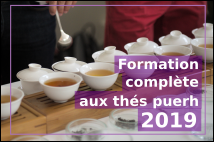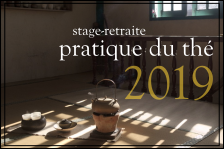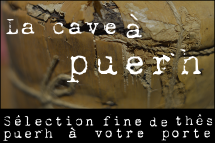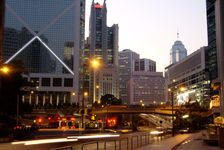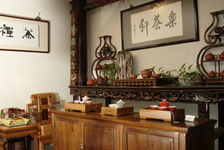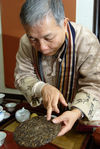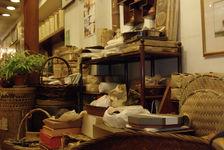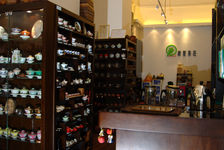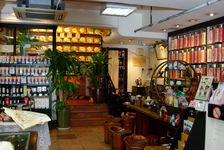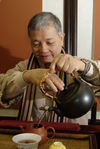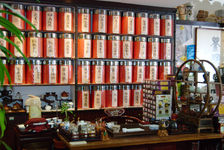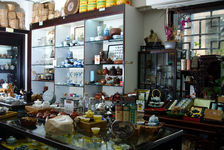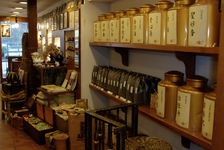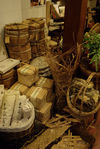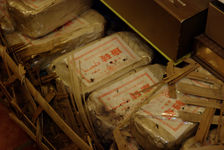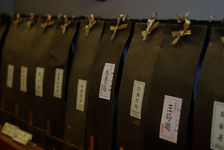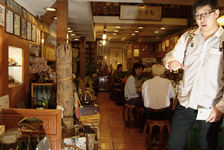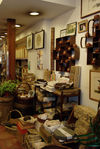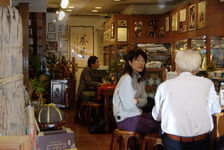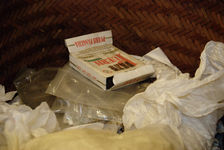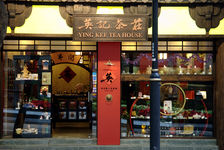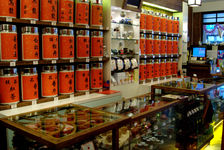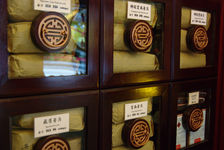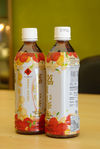 This page is not a real translation but just an automatic translation generated by computer of the original article, written in French language! Its not good... but better than nothing!
This page is not a real translation but just an automatic translation generated by computer of the original article, written in French language! Its not good... but better than nothing!Want to help us do diffuse puerh tea culture in english, by providing a better (or corrected) translation?
Please contact us!

Hong Kong is one of the temples of puerh, especially puerh (Pu Er tea) old, and a dream destination for many enthusiasts and collectors puerh. Although located in a straight line to a thousand kilometers in Yunnan, Hong Kong has played an important role in the history of tea puerh, which I will come in future articles. This is particularly today with Taiwan one of the places of worship puerh (Pu Er tea) old, and Hong Kong are some of the finest collections and stocks puerh (Pu Er tea) old. Moreover, it is almost exclusively in this form that the puerh (Pu Er tea) is consumed in Hong Kong, and in general, maps teahouse are made up only of puerh (Pu Er tea) "dark" or older to at least 10 or 20 years, ie fermented teas younger.
market puerh (Pu Er tea) older is really a separate market, an article would not suffice to present and non geek can quickly become disoriented, particularly because of the multitude and variety of products found in Hong Kong. The puerh (Pu Er tea) being aged in Hong Kong has long been a product consumed, and therefore a very common product, it is first necessary to separate puerh (Pu Er tea) everyday consumer, generally highly influenced by their age and price that can still be affordable, puerh (Pu Er tea) of amateurs, or for more individuals and puerh (Pu Er tea) listed or collectibles. The latter are still a world apart, approaching more nearly the antiquities market as that of tea lovers. Like any rare and old, there is indeed a number of teas, from historical producers, highly sought by collectors and can fetch prices quite unimaginable. In this range, there is generally no longer just about flavor, and teas are known to collectors by making it possible to identify this vintage series or rare, scarcity is the main factor defining the dimension of these teas. < /p>


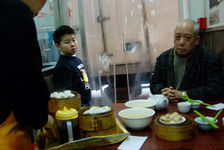
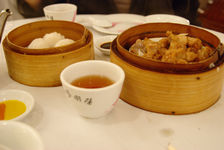
- 1. Detail of a collection of cake
- 2. Etallage a small tea shop in Hong Kong
- 3. Cha Lou, very popular tea room where we eat a very long time of dark puerh (Pu Er tea)
- 4. aged Puerh accompanying Dim Sum (steam) in a teahouse in Hong Kong
Just in terms of teas just doomed to be consumed, we find on the shelves of teahouse in Hong Kong, in addition to the variety of vintages and producers, a wide variety of characters, depending on storage conditions of these teas, ten times more the huge range of what the city holds. The older puerh (Pu Er tea) develop, indeed, radical differences of characters under the conditions of storage; in particular conditions such as humidity, temperature and air exchange, characterize the different phases of storage that tea will lived. It is often said that due to the tropical climate, heat and high humidity of Hong Kong, there are stored puerh (Pu Er tea) are strongly influenced by the moisture and flavors have "wet". But it is very simplistic and inaccurate and partially found in Hong Kong of teas from many different, offering a wide variety of flavors. Indeed the presence in Hong Kong, many teas from wet storage, is more in the tea culture of this region than in reality climate of the island. If indeed, the climate outside Hong Kong can be particularly wet, Hong Kong is a city developed, where we control for a long time indoor climatic conditions, whether homes or businesses (few people live or are shopping in the environment at 90% moisture) or stocks, whether of food, or many manufactures, including paper-based or technology.
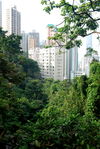
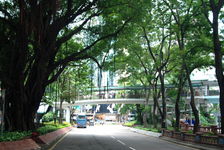
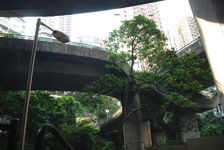
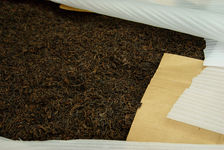
- 1. Hong Kong, a city thrust into the rainforest
- 4. old Puerh from a Dry Storage in Hong Kong (Vesper Chan)
wet storage of puerh (Pu Er tea) is something wanted, desired and controlled, and not a fatality related to the ambient environment. The presence in Hong Kong as many puerh (Pu Er tea) has undergone a number of years and the humidity is above all linked to local consumer tastes, and the high consumption of puerh (Pu Er tea) old in everyday life , therefore pushing to shorten the longer the maturity of puerh (Pu Er tea) so that it becomes "oral" Hong Kong people for the consumer. A number of puerh (Pu Er tea) the Hong Kong market from elsewhere inventory located in China (including Guangzhou), offering the wet storage to a single shot, facing the astronomical real estate prices in Hong Kong.
He who knows Hong Kong, will therefore find, not only puerh (Pu Er tea) marked by a wet storage, but also teas stored in much drier atmosphere, and a multitude of two, usually from a fine dosing between wet storage and dry storage. Because Hong Kong is not that a huge stock of old puerh, and Hong Kong's aging puerh (Pu Er tea) is a culture in which some have become master in the art of carving, with the years, the character of a given tea. For this, we sometimes move from one room to another storage, built in different ways and in different materials, but also in different parts of the island (which despite its small size, offers weather highly variable from one point to another). Then we refine things, not least by moving a thong between the first and sixth floor of a building or even the first level and the sixth level of a shelf, this having on the long term a clear influence on tea!
A number of collections and inventories, particularly for teas listed or the wholesale market, have not set up shop, and it should be introduced or to be the middle of puerh (Pu Er tea) for access. But rest assured, the hobbyist also find plenty to be put in their mouths and great teas to buy, among the multitude of small shops, often lack information and sometimes a bit dubious but in which there are from time to time the gem, and the famous tea house, usually in place for many years. The latter often have three distinct audiences. The general public in search of fine teas and even the tourist or the person passing through Hong Kong, for those located in the busiest, most of the products highlighted him being generally intended. Then the connoisseur, often student or former student of tea masters behind these signs, and looking precisely some teas. The third category consists of collectors, enthusiasts teas exceptions listed or collectible categories including general public is often unaware of the existence. According to the shops, these products are put forward, glimpsed or back shop, the bulk of the clientele of passage generally not starting again with a cake to several thousand euros under his arm.
These tea shop known I selected for you some, I highly encourage you to go explore on your next trip to Hong Kong, you just looking to bring a good tea, a tea exception See THE cake historic crown your collection!
Lock Cha Tea Shop (Wingchi Ip)
290B Upper G /F, Queen's Road, Central /Sheung Wan, Hong Kong
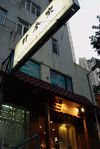
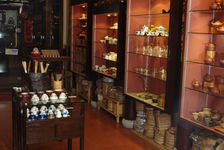
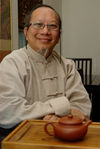
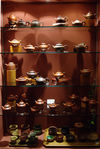
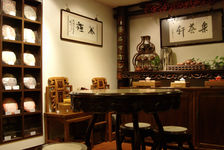
- 1. Lock Cha Tea Shop
- 3. Wingchi Ip, founder of Loch Cha
- 4. Teapots at Lock Cha Tea Shop
- 5. Lock Cha Tea Shop
Whether the prestigious tea hosted by the teaware museum, or shop in the district of Sheung Wan , Lock Cha is, without any hesitation Part of the best places for the tea lover and collector of puerh (Pu Er tea) exception. Behind these two institutions, Wing Chi Ip, one of the biggest names in tea and ceramics in Hong Kong. Great collector of teapots Wing Chi Ip exception is also a leading scholar of Zi Sha teapots (earth "Violet" at the origin of the famous Yixing) and is among the first to be imported and promoted these teapots, in the 80s, Hong Kong. But Wing Chi Ip has also long been one of the greatest specialists puerh, and is particularly visiting professor at various universities in China, Executive Director of the World Tea Union, a founding member of the Hong Kong Tea Association and consultant of the Fujian Tea Culture Association and Yunnan Tea Association.
The history of Lock Cha Tea Shop begins in 1991, a small retail store in Shatin , Hong Kong. At that time, all Chinese tea arriving in Hong Kong went through Chinese state enterprises (CNNP) and were generally mixtures of grades and qualities of medium and was often re-roasted in Hong Kong. Where Lock Cha stands quickly is by its own import channels of green tea and oolong, somewhat on the fringes of what was then asked by the Chinese government. And especially by a tea of the season and unique soil, directly from small producers Chinese, who, by their difference, worth quickly Lock Cha a solid reputation.
At the opening of China in 1999, Lock Cha is expanding with the opening of a particular import-export business in mainland China, ceramics workshop in Xing Yi, and finally in 2003 to a prestigious teahouse in the heart of the Museum of teaware. The puerh (Pu Er tea) is, of course, not shelved, and Shih Wing Ip quickly developed a passion for tea, he will actively monitor all developments over the past 20 years. This from Hong Kong, but also with countless trips to China which will bring together a very impressive collection of teas.
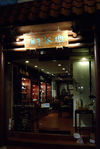
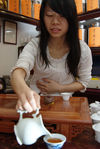
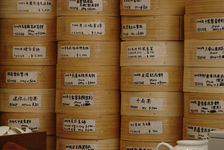
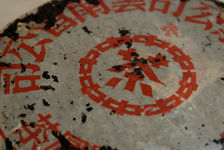
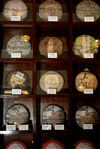
- 1. Entry Lock Cha Tea Shop
- 2. tasting teas in the shop
- 3. Samples of the teas offered by Lock Cha
- 4. Red Mark, a prestigious collection of tea
- 5. Some cakes offered by the shop
Today Lock Cha Tea Shop has the appearance of a small shop Queen's Road , between Central and Sheung Wan . Warm light and soft, elegant and refined decoration, one is immediately struck by entering Lock Cha by the calm, the silence and tranquility prevailing in the place where it was immediately invited to taste some great wines. Here are some teas window displays, the exhibition space being used for most parts of ceramics and fine china. It is therefore essentially to the tea table that this is happening. Behind rows of glass jars and stacks of boxes of bamboo, like baskets of Dim Sum vapors of the city, the samples contain a large collection of quality teas selected by Wingshi Ip. Besides green tea, oolong and white, there are many puerh (Pu Er tea) quality from the past 30 years, some of which are fabulous (at prices ranging from less than 100 euros a few hundred euros). For collectors or serious hobbyists, it's back shop that's going on, to where many of the large slabs that marked the history of puerh. The collector may include dreaming in front of authentic red and blue mark mark of 50 years, or to buy things "slightly" more affordable as yellow mark of 70 years.
The Best Tea House (Vesper Chan)
G /F, Great Wall Factory Building
11 Cheung Shun Street, Lai Chi Kok,
Kowloon (Hong Kong)
One of the essential address in Hong Kong for the amateur puerh (Pu Er tea) course The Best Tea House , which now has four stores in Hong Kong (two on the island of Hong Kong and two Kowloon ), and whose principal and most prestigious is at 11 Cheung Shun Street in of Lai Chi Kok (Kowloon) . Besides the shops of the island, The Best Tea House has now implemented in Canada and will open in mainland China later this year. That is there are over 20 years, in 1988, as Vesper Shan, one of the other great tea masters of Hong Kong, founded with his own money The Best Tea House , it directed since, with reason and understanding, combining with great balance passion and knowledge of tea with business acumen.
Vesper Chan is probably one of the first island to be interested, from the 90s, youth puerh (Pu Er tea) green, in a context where we did not drink in Hong Kong that the puerh (Pu Er tea) old, and is considered one of the pioneer of dry storage, the opposite of what was then practiced in Hong Kong. The famous 88 qing, a 7542 from the late 80s, whose entire stock was bought by Vesper Chan, shortly after production and stored by him in dry environments is especially back in history and the fact puerh (Pu Er tea) part of must have many collectors. In addition to this famous cake, Vesper Chan store for 20 years many renowned tea and, besides being an expert in the art of brewing tea, it is now considered a leading scholar of storage but also oolong puerh (Pu Er tea) . Amateur young puerh (Pu Er tea) since its inception, he also produced, in recent years, various prestigious puerh, including a cake made exclusively from one of the oldest tea trees in Yunnan, and oversees various production and storage (dry ) in Yunnan.
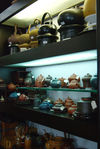
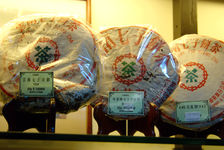
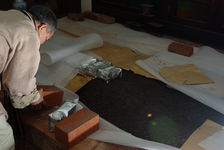
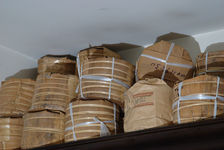
- 1. Some teapots each proposed by The Best Tea House
- 2. Some few of the many Tse Chi Cha Been dreaming of the Best Tea House
- 3. In the back room, part of the old stock of Vesper Chan , stored in dry storage
- 4. Behind the shop, part of the old stock of Vesper Chan, stored in dry storage
The main store at Kowloon is a true cave of Ali Baba: green teas, white, oolong young and old, high-quality, but also a multitude of beautiful pieces, old teapots, and of course, of puerh (Pu Er tea) exception. The amateur or collector who can afford it will benefit, no doubt, the opportunity to get their hands on some rare specific home, like a small piece of the famous 88 qin (a few hundred euros for 100g ), or other more affordable puerh (Pu Er tea) or oolong, stored by Vesper Chan. Of course, the great classics and other collectibles puerh (Pu Er tea) are not missing, and the shelves of the Best Tea House dreams. Multitudes of Tse Chi Cha Been, 7542 the last 30 years (starting between 500 and 3000 euros per wafer), or in smaller budgets of green and yellow marks 90 years to 2000. In addition to these classics, you will find many pancakes least publicly known but equally prestigious, dating from 80 and 90 and starting at a few hundred euros. For smaller budgets, we will also find puerh (Pu Er tea) bulk, 10 to 30 years old, at prices much more reasonable (less than 100 euros per 100g).
But where the sign also stands within the landscape Hong Kong people, it is in the selection of young puerh (Pu Er tea) rough it offers. Vesper Shan is not for nothing one of the first in Hong Kong to have appreciated, supported and backed the young puerh (Pu Er tea) crude the Best Tea House appears as one of the few places in Hong Kong where the we will offer you advice and quality of raw puerh (Pu Er tea) the past 5 years, from different producers and finely selected by the house. Among them, a series of premium cakes and thoughts produced by Vesper Chan, some of which, tasted on the spot, are actually very high quality.
Finally the lover of tea, whether the puerh (Pu Er tea) or oolong, do not hesitate certainly enjoy his stay in Hong Kong, if this is possible, take a course or join a course that famous master provides on-site since the 90s, and improve their skills and knowledge in his tea and the art of gung fu (inquire locally).
Yabo cha fang (Yip Wai Man)
Jiulong lao jie jie wangjiao ago 120 hao c dixia
Hong Kong
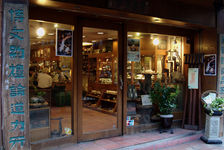
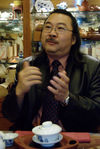
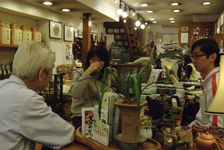
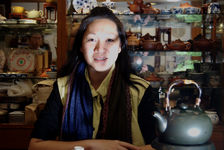
- 1. Yabo cha fang
- 2. Yip Wai Man, founder of Yabo cha fang
- 3. Yabo cha fang
- 4. Eliza Liu, who manages Yabo cha fang
May be less recognized than the two previous signs, Yabo cha fang , undoubtedly one of the best tea shop in Hong Kong is a place not to miss. Founded by Yip Wai Man Liu and maintained by Eliza one of his students, the place is a reflection of this atypical character. Yip Wai Man is first a great teacher and specialist Hong Kongers tea and puerh, but also and especially for someone who is primarily a tea culture, and that has continued throughout his life to work for the cultivation of tea and its dissemination through various media, by the books he wrote, but also more innovative media such as radio or television. And it earned him a number of happenings particularly surprising, as climbing the heights of the Himalayas with a small group, to make tea, or to compare the slow and quiet of gung fu with the speed and noise by organizing a tasting detonating in the middle of a Formula 1 circuit ... But beyond these performances, tea, above all, to Professor Yip a social dimension, is a link between people, and it is this dimension that is found behind its various initiatives, whether or Event take place in space as Hong Kong Tea Shop, a tea garden or experimental, an open space dedicated to the practice of music he created for the youth of Hong Kong.
Yabo cha fang has a unique atmosphere. Although completely open, the store does not look like a totally public place, but more like a club, association or place reserved for members. Inside, cozy atmosphere, filtered, and piles of cakes and other teas, giving almost like coming from an antique dealer. Among them, many major references of the past 30 years, but also many lesser-known teas some of which deserve to be drops! But beyond this arrangement neat and warm, we appreciate the warmth that emanates from the atmosphere. Here we come to meet, exchange, share of tea in front of a few cups and it is likely to meet other fans of good stories.
The teas offered are of course up to the atmosphere in this shop, whether it be beautiful pieces of old teas, the puerh (Pu Er tea) more accessible, but also teas fresh, green, white and oolong very high quality. The site also offers a number of Yixing teapots, cups and other accessories, not data, but particularly sharp in the making. Note in particular the different series that have been thought out and designed by Yip Wai Man to make the most of each type of tea. A book, edited by Professor Yip and available in the shop also has these different pieces and briefly describes the art of infusing each type of tea with them.
The shop is staffed by specialist tea, trained by Professor Yip, we also greatly appreciate the quality of information and advice given on the teas, the skill with which they are prepared, but also the passion of those who inhabit the site. Far from a commercial speech devoted to extolling the products of the house, the discussions quickly derived products to other aspects of tea culture, experiences and shared knowledge. Finally, and although it is a tea shop , is in custody and holds out in the highlighting of cultural and social dimension, which transpired into the atmosphere of the place, a where as an amateur of tea is in its place.
Ying Kee Tea House (Chan Ying Chau and Sons)
2-4 Hysan Avenue, Causeway Bay Hong Kong
Ying Kee is the great banner of tea in Hong Kong. With 14 stores, Ying Kee , which is known to everyone in Hong Kong is present in almost every district into the hall of the airport. Billed as the oldest tea shop in Hong Kong, the first Ying Kee Tea House has been founded in 1881 by Mr. Chan Chau-ying to Quangzhou, mainland China, and moved in 1950 to Hong Kong and is now managed by the fourth generation of family Ying.
We regret greatly that by seniority against vaunted by communicating Ying Kee as it is more than a selling point. Many things have happened since the founding of the first shop in 1881, and four generations later it is much more likely intentions of the past. It is also difficult to get an idea of what the Ying Kee of old, the parent company itself with no paper on the subject. What seems especially motivating Ying Kee since the early 2000s is the expansion and profit. Much of the modernization of the brand and started in 2005, with a clear objective and announced: become an international brand. In addition to 14 shops in Hong Kong, which has been modernized to attract young people, while trying to keep an aesthetic inspired by "traditional Chinese", Ying Kee now sells in Japan, where, after closing the only existing shop They distribute their products in grocery stores in the form of plastic bottles (fresh tea industry), but is also present in Italy and the Czech Republic
Visiting the shop Ying Kee best-known Hong Kong, Chinese-inspired contemporary design, is a reflection of this evolution. Here the map to the tasting tea, everything has been simplified to attract new customers (trying not to lose too old). More gung fu or tea table, tea is given to taste in paper cups. Puerh side, a range of six products, the brand name, with no other information than their age, two fermented puerh (Pu Er tea) 3 and 6 years of age, and gross puerh (Pu Er tea) 7, 9, 15 and 20 of age prices ranging from fifty to several hundred dollars.
In short, while leaders seem very satisfied with the evolution and growth of the company, and while many customers in Hong Kong and elsewhere are very pleased with the teas offered by this sign, Ying Kee has little of interest to the amateur puerh (Pu Er tea) true.
Hopefully this small review of some of the best tea shop in Hong Kong will be useful and help you make your next trip to Hong Kong, please give us your impressions and personal opinions on these properties!

